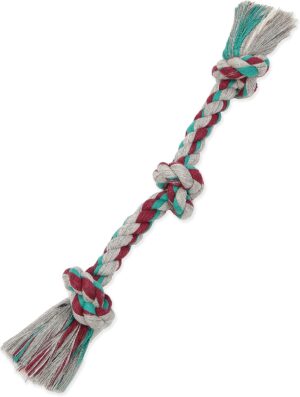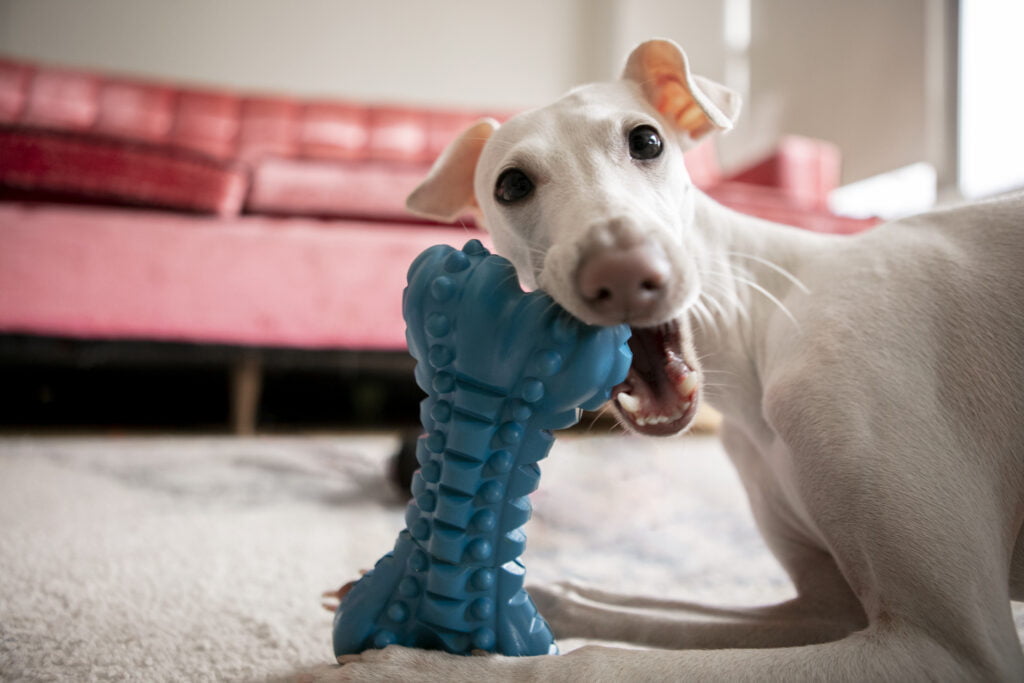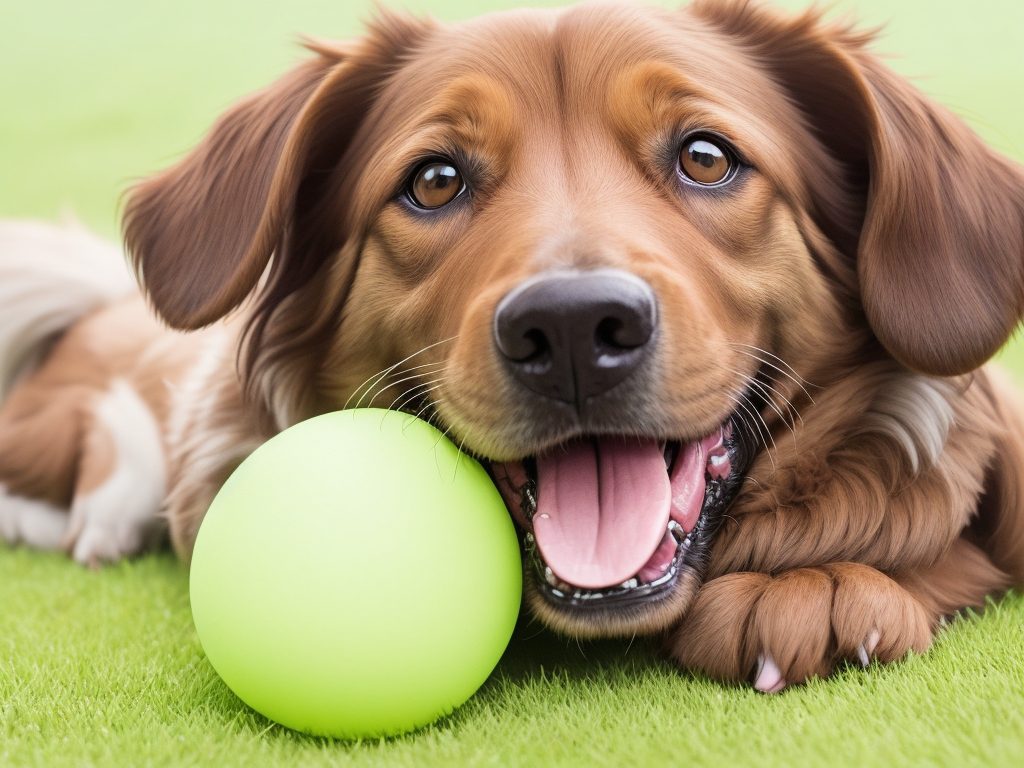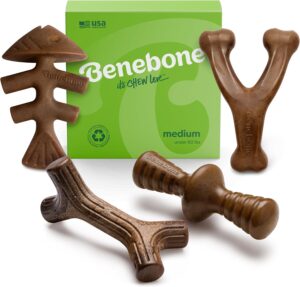When it comes to our furry companions, their safety and well-being are paramount. One often overlooked aspect of pet care is selecting the right toys. In this article, we’ll delve into the critical matter of dog toy materials, differentiating between safe and unsafe options. Understanding what to look for can help keep your canine friend out of harm’s way while ensuring hours of joyful play.
Table of Contents
I. Understanding Dog Toy Materials
Dog toys come in a wide array of materials, each with its unique properties, advantages, and potential drawbacks. Understanding these materials is crucial for making informed choices that ensure your dog’s safety and enjoyment during playtime.
1. Rubber Toys: A Durable and Resilient Option
Rubber dog toys are a popular choice due to their durability and versatility. They can withstand rigorous chewing and provide excellent bounce for interactive play. Natural rubber is non-toxic and safe for most dogs. However, it’s essential to inspect rubber toys regularly for signs of wear or damage, as sharp edges can develop over time, posing a risk to your pet. High-quality rubber toys often come in various shapes and textures, designed to stimulate your dog’s interest and promote dental health.


Aggressive Chew Toy for Dogs | Tough Rubber Dog Toy | Dental Cleaning and Interactive Play


Arm & Hammer Aggressive Chewer’s Rubber Dog Toy – Durable, Dental Health-Boosting Chew Toy


Chew King Supreme Rubber Fetch Toy for Dogs – Durable, Interactive, Natural Rubber, Dental Care, Tough Chewer


Durable Rubber Chew Toy for Aggressive Chewers – Long-Lasting Fun for Your Dog
2. Plush Toys: Soft and Cuddly, but Not Without Risks
Plush toys are beloved for their cuddly appearance and comfort. Dogs often enjoy carrying them around and cuddling with them. However, plush toys are not without risks, particularly for aggressive chewers. They can easily tear, and the stuffing inside, which is often made from polyester fiberfill, foam, or plastic beads, can pose a choking hazard if ingested. If you choose plush toys, opt for those with reinforced stitching and durable materials. Always supervise your dog when playing with plush toys.
3. Nylon Toys: Sturdy and Long-Lasting
Nylon is a strong and long-lasting material commonly used in dog toys, especially for those designed for heavy chewers. Nylon toys are typically non-toxic and resistant to wear and tear. They can help satisfy your dog’s natural chewing instincts while providing a safe outlet for their energy. However, ensure that the toy is the appropriate size for your dog, as smaller pieces can break off and potentially be ingested.
4. Rope Toys: A Mix of Fun and Dental Health
Rope toys are a favorite among dogs who love to tug and chew. They are often made from cotton or other natural fibers and can promote dental health by assisting in cleaning your dog’s teeth as they chew and play. While rope toys can be a safe option, they should be monitored for fraying and worn-out threads that your dog may ingest accidentally. To enhance safety, choose rope toys designed specifically for dogs, which are typically more durable and less likely to unravel.


Durable 3-Knot Rope Dog Toy for Aggressive Chewers – Flossy Chews Cottonblend – 15 Inch


Durable Dog Rope Toys for Aggressive Chewers – Indestructible Teething Toy for Large Breeds – Dental Health and Interactive Fun – 5-Pack


Feeko Aggressive Chewers Dog Toy – Indestructible Rope Toy for Cleaning Teeth and Endless Fun
5. Plastic Toys: A Cautionary Choice
Plastic dog toys can range from safe to hazardous. Some plastics may contain toxic chemicals like BPA and phthalates, which can be harmful to your dog’s health if ingested. Always check for labels indicating that the toy is made from safe, non-toxic plastics. Be cautious of cheap or low-quality plastic toys, as they may break easily, posing a choking hazard. When opting for plastic toys, choose those from reputable brands known for their commitment to safety standards.
By understanding the materials used in dog toys, you can make informed decisions that cater to your dog’s needs, ensuring they have safe and enjoyable playtime experiences. Regularly inspect toys for wear and tear, and remember that each dog is unique in their playstyle and preferences, so choose toys that match your pet’s activity level and size. In doing so, you can provide your furry friend with the best playtime experiences while keeping them safe and sound.
II. Safe Materials for Dog Toys

Selecting the right materials for your dog’s toys is paramount to their safety, enjoyment, and overall well-being. Safe materials not only offer durability but also peace of mind, knowing that your furry friend can play without risk. In this section, we’ll explore several safe dog toy materials that you can confidently incorporate into your dog’s playtime routine.
1. Natural Rubber: A Durable and Safe Option
Natural rubber is a top choice for dog toys, and for good reason. It is non-toxic, resilient, and can withstand even the most enthusiastic chewers. This material is ideal for dogs who love to gnaw and play vigorously. Natural rubber toys come in various shapes and textures, providing mental stimulation and helping to clean your dog’s teeth as they chew. Look for high-quality rubber toys from reputable brands, which are often free from harmful chemicals and additives.
One of the notable advantages of natural rubber toys is their versatility. They can be used for interactive play, fetching, or as a soothing chew toy. They are easy to clean, and typically dishwasher-safe, making maintenance a breeze. Regularly inspect these toys for signs of wear and replace them if they become damaged or develop sharp edges.
2. High-Quality Silicone: Flexible and Non-Toxic
Silicone is another safe and flexible material commonly used in dog toys. It is non-toxic, making it a suitable choice for most dogs, including puppies and seniors. Silicone toys can come in various shapes and sizes, providing options for both solo and interactive play. They are gentle on your dog’s mouth and have a satisfying texture that many dogs enjoy.
Silicone toys are particularly beneficial for teething puppies, as they offer relief for sore gums. They are easy to clean and maintain, typically requiring a simple rinse or wipe-down. While silicone toys are generally durable, inspect them regularly for any signs of damage, such as punctures or small tears.
3. Tough, Non-Toxic Plastics: A Budget-Friendly Choice
For those looking for budget-friendly options, tough and non-toxic plastics can be a suitable choice. While plastic toys vary in quality, you can find safe options by ensuring they are free from toxic chemicals like BPA and phthalates. These toys are often designed to withstand chewing and play, making them a good choice for dogs of all sizes.
When opting for plastic toys, consider the size and design carefully. Look for those that are sturdy and less prone to breaking into small, swallowable pieces. Also, ensure that the toy is appropriate for your dog’s size and chewing style, as larger, tougher plastic toys are often designed for heavy chewers.
4. Non-Abrasive Fabrics: Ideal for Soft Toys
Soft fabric toys can be a delightful addition to your dog’s playtime, providing a sense of comfort and familiarity. These toys are gentle on your dog’s mouth, making them suitable for carrying around and cuddling. When selecting fabric toys, choose those made from non-abrasive materials. This ensures that your dog’s gums and teeth won’t be harmed during play.
Keep in mind that while fabric toys are less likely to cause physical harm, they can still pose risks if your dog manages to tear them apart. In such cases, loose threads, squeakers, or small plastic parts can become choking hazards. Always supervise your dog during play with fabric toys and replace them if they become damaged.
Incorporating safe materials into your dog’s toy collection is essential for their physical and mental well-being. Natural rubber, high-quality silicone, non-toxic plastics, and non-abrasive fabrics all offer various benefits, catering to different play styles and preferences. Regularly check your dog’s toys for wear and tear, replace any damaged items to maintain their safety, and ensure that playtime remains a joyful and secure experience.
III. Unsafe Materials to Avoid
While there is a wide range of dog toy materials to choose from, it’s equally important to be aware of the materials that are potentially harmful to your furry friend. Here, we’ll delve into the types of materials and toy features that you should steer clear of to ensure your dog’s safety during playtime.
1. Toxic Chemicals in Plastics: Identifying and Avoiding Them
Some plastics used in dog toys may contain toxic chemicals, such as BPA (Bisphenol A) and phthalates. These chemicals are known to be harmful to both humans and pets. When selecting plastic toys, always check the label for any mentions of BPA or phthalates, and avoid toys with these materials. Opt for toys made from safe, non-toxic plastics to eliminate the risk of chemical exposure. Remember that ingestion of these chemicals can lead to various health issues, so it’s better to be safe than sorry.
2. Harmful Fillers and Stuffing: Risks Associated with Certain Fillings
Many plush dog toys contain fillers or stuffing materials like polyester fiberfill, foam, or small plastic beads. While these materials provide the soft, cuddly feel that dogs enjoy, they can pose a choking hazard if your pet manages to tear the toy apart and ingest the filling. To minimize this risk, choose plush toys with reinforced stitching and durable fabric. Additionally, keep an eye on your dog while they’re playing with these toys, and promptly remove them if you notice any signs of damage or wear.
3. The Dangers of Cheap, Low-Quality Materials
While it can be tempting to go for budget-friendly dog toys, choosing cheap, low-quality materials can come with significant risks. Such toys are often more prone to breaking, which can lead to small pieces that your dog may swallow or choke on. Investing in quality toys, even if they cost a bit more upfront, is a wise decision to ensure your pet’s safety. Look for reputable brands known for their commitment to safety standards and product quality.
4. The Perils of Small, Detachable Parts
Some dog toys have small, detachable parts, such as buttons or eyes on stuffed animals. These small pieces can easily become choking hazards if your dog manages to pull them off and swallow them. When choosing toys, inspect them carefully to ensure that all parts are securely attached and cannot be easily removed. Opt for toys designed with safety in mind, where small parts are either sewn or fastened securely.
Understanding the materials and features to avoid in dog toys is essential for responsible pet ownership. By steering clear of these potentially dangerous materials and toys, you can significantly reduce the risk of accidents and ensure your dog’s safety during playtime. Regularly inspect toys for any signs of damage and replace them as needed, keeping your furry friend safe and happy during their play sessions.
IV. Regulations and Standards


Government regulations and independent testing organizations play a crucial role in ensuring the safety of dog toys. Knowing how to identify certified safe toys can save you from potential hazards.
V. The Importance of Size and Shape
Selecting the right size and shape for your dog’s toys is an often overlooked yet crucial aspect of ensuring their safety during playtime. Both the size and shape of a toy can have a significant impact on your dog’s enjoyment and safety. Let’s delve into why these factors matter.
1. Why Size Matters: Choosing the Right Toy for Your Dog’s Size
Selecting an appropriately sized toy is vital for your dog’s safety. A toy that’s too small can pose choking hazards, while one that’s too large may be challenging for your dog to handle or enjoy.
- Small Dogs: If you have a small breed, such as a Chihuahua or a Yorkshire Terrier, choose toys that are specifically designed for their size. Smaller toys are not only safer but also more comfortable for small mouths and paws.
- Medium Dogs: For medium-sized dogs like Beagles, Bulldogs, or Cocker Spaniels, you have a broader range of toy options. However, always consider the toy’s durability and any detachable parts that could pose risks.
- Large Dogs: Larger breeds, like German Shepherds or Labradors, require robust and larger toys that can withstand their strength. Oversized toys can prevent accidental swallowing, and they’re less likely to break into smaller pieces.
- Heavy Chewers: If your dog is a heavy chewer, regardless of their size, prioritize toys designed for durability. These toys are usually larger and constructed to withstand the rigorous gnawing of strong jaws.
2. Appropriate Shapes to Prevent Choking Hazards
In addition to size, the shape of a dog toy is equally important. The right shape can prevent choking hazards and make playtime more enjoyable.
- Avoid Small Parts: Toys with small parts or components, such as buttons, eyes, or bells, can pose a risk if they become detached. Opt for toys that have securely attached components or avoid them altogether.
- Round or Spherical Toys: These shapes can be challenging for dogs to grip and carry, potentially leading to frustration during play. However, they can be fun for chasing and interactive games.
- Flat, Disc-Shaped Toys: While these toys are easy to carry and toss, be cautious about their durability. Thin, flat toys can be quickly torn apart by strong chewers.
- Irregular Shapes: Toys with irregular shapes often provide more interest and engagement for your dog. They can bounce unpredictably, making playtime more stimulating. However, ensure these toys are made from safe and durable materials.
- Interactive Puzzle Toys: These toys come in various shapes and are designed to mentally stimulate your dog by requiring them to work to access treats or rewards. Ensure that the puzzle toy is the appropriate size for your dog and free from small, detachable parts.
By considering both size and shape when choosing your dog’s toys, you can enhance their safety and enjoyment. Keep in mind that every dog is unique, so pay attention to your pet’s preferences and play style. Regularly inspect toys for signs of damage, such as loose parts, sharp edges, or wear and tear, and replace them as needed to maintain a safe and enjoyable playtime experience for your furry friend.
VI. Durability and Longevity


When selecting dog toys, durability, and longevity are key factors that go hand in hand with safety and value for your investment. A durable toy not only ensures that your dog’s playtime is safe but also provides lasting entertainment and satisfaction. In this section, we’ll explore the significance of durability and longevity in dog toys and offer tips on how to choose and maintain them.
1. The Importance of Durability
Durability is crucial because dogs, especially heavy chewers, can quickly wear out or destroy toys that aren’t built to withstand their enthusiastic play. Here’s why durability is important:
- Safety: Durable toys are less likely to break or splinter, reducing the risk of your dog swallowing small, harmful pieces. This minimizes the chances of choking or intestinal blockages.
- Value for Money: High-quality, durable toys may have a higher upfront cost, but they typically last longer, making them more cost-effective in the long run.
- Mental Stimulation: Durable toys can keep your dog mentally engaged for more extended periods, preventing boredom and destructive behavior.
- Physical Exercise: Sturdy toys can withstand rigorous play, ensuring that your dog gets the physical exercise they need.
2. Selecting Durable Toys
When choosing durable toys, consider the following factors:
- Material: Look for toys made from tough materials like natural rubber, high-quality silicone, or heavy-duty nylon. These materials can withstand strong jaws and frequent chewing.
- Reputation: Opt for well-known brands with a reputation for producing durable toys. Quality brands often invest in research and testing to create long-lasting products.
- Intended Use: Match the toy to your dog’s playstyle. If your dog is an aggressive chewer, select toys specifically designed for tough play.
- Size: Ensure the toy is an appropriate size for your dog. Oversized toys are often more durable and less likely to be swallowed.
3. Extending the Life of Your Dog’s Toys
Prolonging the life of your dog’s toys involves proper care and maintenance. Here are some tips to help you achieve this:
- Supervise Play: Keep an eye on your dog during playtime to ensure they’re using the toy as intended. This minimizes the risk of rough play that can damage the toy.
- Regular Inspections: Check the toy for signs of wear and tear, including punctures, cracks, or loose parts. Replace damaged toys promptly.
- Cleaning: Wash toys regularly to remove dirt, saliva, and bacteria. This not only prolongs their life but also maintains your dog’s hygiene.
- Rotation: Introduce a variety of toys and rotate them to keep your dog’s interest. Toys can lose their appeal if they’re always available.
- Interactive Toys: Consider puzzle or treat-dispensing toys that provide mental stimulation. These toys are less likely to be destroyed quickly.
Incorporating durable toys into your dog’s playtime routine ensures both their safety and ongoing entertainment. By making informed choices and taking care of your dog’s toys, you’ll have peace of mind knowing that your furry friend can enjoy extended play without the risk of harm.
VII. Allergies and Sensitivities


Just like humans, dogs can suffer from allergies and sensitivities that can be triggered by various environmental factors, including the materials used in their toys. Understanding common dog allergies and sensitivities is crucial for selecting safe toys that won’t exacerbate your pet’s condition. In this section, we’ll explore this often-overlooked aspect of pet care.
1. Understanding Common Dog Allergies
Dogs can develop allergies to a variety of substances, and these allergies can manifest in different ways. Here are some of the most common allergens for dogs:
- Food Allergies: Dogs can be allergic to specific ingredients in their food, such as chicken, beef, or grains. Food allergies typically result in skin issues, digestive problems, and itchiness.
- Environmental Allergies: These allergies are often caused by environmental factors like pollen, dust mites, or mold. Dogs with environmental allergies may exhibit symptoms such as sneezing, itching, or watery eyes.
- Flea Allergies: Some dogs are highly sensitive to flea saliva. Even a single flea bite can trigger intense itching and skin problems in these dogs.
- Contact Allergies: Dogs can develop allergies to certain substances they come into contact with, such as certain cleaning products or chemicals. This type of allergy can lead to skin irritation.
2. How to Select Hypoallergenic Materials
If your dog has known allergies or sensitivities, or if you suspect that they might, choosing hypoallergenic materials for their toys is essential. Here are some guidelines for selecting safe, hypoallergenic toys:
- Natural Materials: Toys made from natural materials like organic cotton or hemp are less likely to contain synthetic chemicals or dyes that could trigger allergies.
- Dye-Free and Fragrance-Free: Avoid toys with colorful dyes and added fragrances, as these can be potential allergens. Look for toys that are labeled as dye-free and fragrance-free.
- Certified Non-Toxic: Choose toys that are certified as non-toxic and free from harmful chemicals like BPA, phthalates, and lead. These certifications ensure that the materials used in the toys are safe for your dog.
- Washable and Easy to Clean: Select toys that are easy to clean and wash, as this can help prevent the buildup of allergens over time. Machine-washable toys are a good choice for this purpose.
3. Monitoring Your Dog’s Reaction to New Toys
Even when selecting hypoallergenic toys, it’s essential to monitor your dog’s reaction when introducing a new toy. Dogs can develop allergies or sensitivities over time, so observing any changes in behavior or physical symptoms is crucial. If you notice any signs of allergies, such as excessive itching, redness, hives, or digestive issues, discontinue the use of the toy and consult your veterinarian.
It’s important to remember that each dog is unique, and what may be hypoallergenic for one dog may not be for another. By being attentive to your dog’s needs and potential sensitivities, you can select toys that won’t exacerbate allergies and allow your furry friend to enjoy playtime safely and comfortably. If in doubt, consulting your veterinarian for advice on hypoallergenic toy options is always a prudent choice.
VIII. Eco-Friendly Options for Dog Toys


As the world becomes increasingly environmentally conscious, more pet owners are seeking eco-friendly options for their furry companions. These toys not only benefit the planet but also promote a healthier and safer playtime experience for your dog. In this section, we’ll explore eco-friendly materials and brands leading the way in sustainable dog toys.
1. Sustainable Materials for Environmentally Conscious Pet Owners
- Recycled Materials: Many eco-friendly dog toys are made from recycled materials, including recycled rubber, plastics, and fabrics. By repurposing materials that would otherwise end up in landfills, these toys reduce waste and minimize their environmental footprint.
- Natural and Organic Fabrics: Toys made from organic cotton, hemp, or other natural fabrics are a sustainable choice. These materials are often free from harmful chemicals and dyes, making them safer for your dog and the environment.
- Biodegradable Options: Some dog toys are designed to be biodegradable, meaning they will naturally break down over time and not contribute to long-term waste. These toys are often made from plant-based materials like jute or cornstarch.
- Non-Toxic and Low-Impact Dyes: Toys that use non-toxic, low-impact dyes are safer for your dog and have a reduced environmental impact compared to traditional, chemical-laden dyes.
2. Reducing the Carbon Footprint of Your Dog’s Toys
Choosing eco-friendly toys is just one part of reducing your pet’s carbon footprint. Here are some additional tips to make your dog’s playtime more environmentally responsible:
- Local and Sustainable Brands: Support local and sustainable dog toy brands. These companies often prioritize ethical manufacturing practices and use eco-friendly materials.
- Minimal Packaging: Look for toys with minimal or recyclable packaging. Excessive packaging contributes to unnecessary waste.
- Upcycled and DIY Toys: Get creative and make your dog toys using upcycled materials like old T-shirts or denim. This not only reduces waste but can be a fun DIY project.
- Repair Instead of Replacing: Instead of disposing of damaged toys, try repairing them if possible. This not only saves money but also reduces the number of toys that end up in landfills.
3. Brands Leading the Way in Eco-Friendly Dog Toys
- West Paw: West Paw is known for its commitment to sustainability and eco-friendly practices. They use recycled and recyclable materials in their toys and are a certified B Corp.
- Planet Dog: Planet Dog is dedicated to producing durable and eco-friendly toys. Their Orbee-Tuff line is made from recyclable materials, and they focus on reducing their carbon footprint.
- Honest Pet Products: This brand offers toys made from organic and natural materials, ensuring a safer and greener playtime for your dog.
- Beco Pets: Beco Pets creates toys from recycled plastic bottles and sustainable materials. Their toys are designed with the planet and your pet’s enjoyment in mind.
Eco-friendly dog toys are not only a responsible choice for pet owners but also offer safe and sustainable options for our furry friends. By opting for toys made from recycled, natural, or biodegradable materials, you can enjoy playtime with your dog while contributing to a healthier planet.
IX. Best Practices for Safe Play


Ensuring safe playtime for your dog is a crucial aspect of responsible pet ownership. By following best practices, you can minimize the risks associated with toys and make playtime both enjoyable and secure for your furry friend. This section explores key guidelines for safe play with your dog.
1. Supervision: The Key to Safe Play
One of the fundamental rules of safe play is to supervise your dog during playtime. This oversight allows you to intervene if any issues arise and ensures that your dog doesn’t engage in behavior that could lead to accidents. Even with toys designed to be safe, dogs can sometimes surprise us with their resourcefulness. Keeping a watchful eye on your pet is the most effective way to prevent mishaps.
2. Regularly Inspecting Toys for Wear and Tear
No toy is indestructible, and over time, even the most durable ones can show signs of wear and tear. Regularly inspect your dog’s toys for damage. Look for punctures, tears, or loose parts that could pose a choking hazard. Replace any compromised toys promptly to prevent accidents.
3. Rotating and Cleaning Your Dog’s Toys
Rotating your dog’s toys keeps playtime interesting and engaging, but it also serves a safety purpose. Dogs can become overly attached to a single toy, causing them to chew it excessively. By rotating toys, you can prevent excessive wear on one toy and minimize the risk of your dog ingesting small parts.
Cleaning your dog’s toys is also essential. Toys can accumulate dirt, saliva, and bacteria, which can pose health risks. Follow the manufacturer’s cleaning recommendations for each toy or use mild, pet-safe cleaning solutions to keep them fresh and hygienic.
4. Match the Toy to Your Dog’s Age and Size
Selecting toys appropriate for your dog’s age, size, and breed is a crucial safety consideration. A toy too small may present a choking hazard, while a toy too large can be challenging for your dog to handle. Puppies have different play needs than senior dogs and certain breeds have specific preferences. Take these factors into account when choosing toys for your pet.
5. Be Mindful of Play Style
Each dog has a unique play style, and it’s important to choose toys that match your dog’s preferences. Some dogs love to chew, while others prefer interactive toys. Understanding your dog’s play style ensures they remain engaged and satisfied during playtime.
6. Use Interactive and Puzzle Toys for Mental Stimulation
Interactive and puzzle toys are not only fun for dogs but also provide mental stimulation. They keep your dog’s mind engaged, which can help prevent boredom and destructive behavior. Interactive toys often involve treat-dispensing or hide-and-seek features that challenge your dog and promote problem-solving skills.
7. Choose Toys from Reputable Brands
Opt for toys from reputable brands that prioritize safety and quality. These brands often invest in research, testing, and quality control to produce toys that are less likely to pose risks to your dog. Look for toys that are certified as non-toxic and free from harmful chemicals.
By adhering to these best practices, you can create a safe and enjoyable playtime environment for your dog. Ensuring proper supervision, regularly inspecting toys, matching them to your dog’s needs, and maintaining cleanliness all contribute to a safer and happier playtime experience for your beloved canine companion.
Choosing Safe Dog Toy Materials: A Summary
Choosing safe dog toy materials involves a combination of informed decision-making and responsible pet ownership. By following the guidelines outlined in this article, you can ensure your furry friend’s playtime is not only enjoyable but also free from potential dangers.
In the end, investing in high-quality, safe toys is a small price to pay for the joy and well-being of our loyal companions. Your dog will thank you with boundless enthusiasm, knowing that their playtime is worry-free and filled with happiness.
FAQs
Q1: Are there any specific symbols or certifications I should look for on dog toy packaging to ensure safety?
A1: Yes, look for certifications such as ASTM F963, which indicates compliance with safety standards, and symbols like “BPA-free” or “Non-toxic.”
Q2: Can I make homemade dog toys to ensure their safety?
A2: While homemade toys can be safe, it’s crucial to use appropriate materials and supervise your dog during play to prevent any accidents.
Q3: What are some eco-friendly dog toy materials and brands I can consider?
A3: Sustainable materials like recycled rubber and hemp, and brands like West Paw and Planet Dog, offer eco-friendly dog toys.















